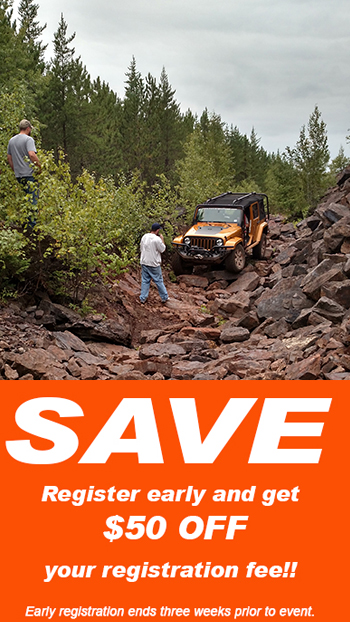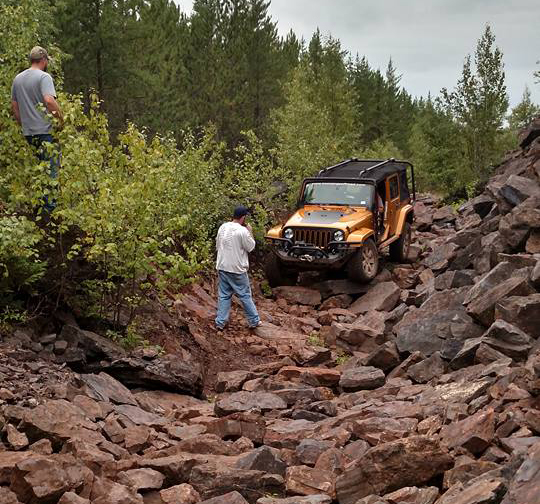Breathe deeply, close your eyes, and lean your head back.
Let the stress flow from your body as a peaceful aura washes over you. Try to relax and get in touch with your senses. That doesn’t sound like good advice for a Jeep driver…or does it? Actually, using your senses is a critical part of driving well.
Consider your sense of sight. It’s a vital part of identifying the trail around you, helping determine that safest and smartest route. One of the things we talk about in classes at the Iron Range Off Highway Vehicle Park in Gilbert, MN is “seeing” the trail in your mind’s eye. Often times rocks that were safely out of the way seem to magically reposition themselves in the worst possible locations. They didn’t really move…you just weren’t quite where you though you were, or forgot to take into account their location relative to the other rocks. As you roll forward they disappear from your view, until surprising you with a solid “thunk” when you hit them squarely, or shrill screech when a skid plate drags over the protrusion.
Being able to take a “mental snapshot” of the trail ahead is critical. It’s a skill that comes as second nature to an experienced driver, but for the novice there is so much information coming at them so quickly that some important details sometimes get left out. This mental snapshot is especially important when climbing hills. One of the first modules covered in a weekend class is hills and hill climbs. Customers learn how to climb up and back down and the comment that often is overheard (right after the screaming and high-fiving ends) is “I couldn’t see anything once I started going up…just blue sky.” Of course, that’s where that mental snapshot keeps you on track. You know the trail is clear and there’s a slight left turn at the crest of the hill. The picture in your mind is crisp. It gets tougher when you need to keep updating the picture as a technical section of trail demands finesse with the steering wheel and deft use of the right foot on the throttle.
Ah, the throttle…here we get to consider the sense of touch! People often describe the ability to do something perfectly as having “the touch”. When the quarterback lofts a pass into the receiver’s outstretched arms where no defender has a chance to make a play, the announcer praises the quarterback’s touch. Well, driving has similar nuances. Knowing exactly how much throttle to apply, adding that power smoothly, backing off at just the right moment to regain control of the vehicle, and getting back into the throttle gently to maintain momentum is a skill that requires practice. When you nail it, the ride is smooth, the progress is steady, and you rarely get stuck. Having the touch, indeed!
A touch technique we practice during classes is left foot braking. Most of us were taught to drive with the right foot to operate the throttle and brake (that makes it less likely you will apply both at the same time), and the left foot to operate the clutch. Now that so many automatic transmission equipped Jeeps are hitting the trail, a new generation of drivers have nothing to do with that left foot. I encourage them to try using the left foot to apply some brake pressure. It can help manage speed downhill and sometimes help find traction when a tire is spinning.
Because an open differential will apply power down the path of least resistance, a Jeep with one tire in the air will always spin that tire, with the other doing nothing to assist forward progress. By carefully applying the brakes with the left foot, and still applying gentle throttle with the right, the spinning tire can be “slowed” enough to allow the differential to transfer some power to the other side. It does not replace a limited slip or locking differential, but it might allow you just enough progress to bring the airborne tire back down to the ground. Because many people are so used to driving with their right foot only, the left foot “touch” takes a while to develop.
Another sense that gets used on the trail is the sense of hearing. In addition to the thunk and screech mentioned earlier, I am always listening for clues. The thwap, thwap, thwap sound is the lugs on the edge of my tire tread hitting a leaf spring (or fender flare) in a hard left turn…nothing to be concerned about. The ticking sound of a hot motor is fine, as long as I hear the whine of the electric fan kick in at the pre-determined temperature. Sometimes I hear a strange noise and I immediately try to determine if it a rotational sound (speeds up as my speed increases) or a steady sound (indicating something not directly related to the driveline). Whatever hints my ears give me, I am already considering the possibilities and trying to determine the severity of the sound. The sweetest sound (and one I rarely get to enjoy) is my wife saying. “you drove that section of trail really well…let’s do that again.”
The sense of smell is a critical Jeep driving skill. Can you identify the subtle nuances between burning oil and hot transmission fluid? How about the sweet scent of anti-freeze? Some days I can smell fear in my customers when they watch my Jeep disappear over the edge of the hill, and they know they are next to descend. Using all our senses to know what is happening around us is a skill our caveman ancestors perfected. They just never imagined how the species would evolve. Nevertheless, I still argue that we have to use all our senses to be in a “Zen-like” state…at one with the Jeep…able to hear, see, smell, and feel everything the Jeep feels to make our driving experience as close as possible to “be” one with the Jeep (or let the Jeep “be” one with you).
At this point you probably guessed the last sense was the sense of taste, and that couldn’t possibly play too big a role in Jeeping (unless you had to follow a Jeep with a set of chrome “testicles” hanging off the hitch). I will take a little writer’s liberty here and declare that the final (and perhaps most important) sense in Jeeping is: Common Sense.
It is a sense that is not as common as you might think. People do silly and stupid things, and after watching too many dangerous situations develop, I started Iron Range Offroad specifically to address safety issues and environmental concerns. Keeping your hands, feet and head inside the vehicle at all times…wearing your seatbelt and NOT drinking and driving…taking pictures and giving advice from a safe distance…these are simple and straightforward concepts that (too often) get overlooked in the excitement of a day on the trail. Keep in mind that it’s NEVER acceptable for someone to get hurt on the trail, and getting LUCKY is just another way of saying my habits are sloppy and I need to step back and reconsider what I am doing. Remember that you have the power to influence the people around you, and by just saying, “wait a second…I have a question”, you might be able to stop someone from acting out a bad decision. Take a moment and think the situation through. When talking the scene out with others, a lot of good concerns can be raised, considered, and ultimately addressed. “Be” the one with common sense in your group. Everyone around you will be glad you are!
Iron Range Offroad is Minnesota’s only offroad driving school. The classroom setting is the spectacular Iron Range OHV Park, 3 hours north of Minneapolis and St. Paul. The classes are geared toward entry level Jeepers, stressing safety and environmental responsibility. Trail riding is broken up with class modules that cover trip preparation, vehicle maintenance and repair, driving skills for different terrain, extraction techniques, vehicle upgrades, and much more. Customers who register for classes also receive a copy of Jim Allen’s book, Four Wheeler’s Bible, Second Edition, an amazingly complete and detailed volume that incidentally features some fine photography of the Iron Range OHV Park and one of the offroad driving classes. To sign up for a trip or request additional information, visit www.ironrangeoffroad.com.












